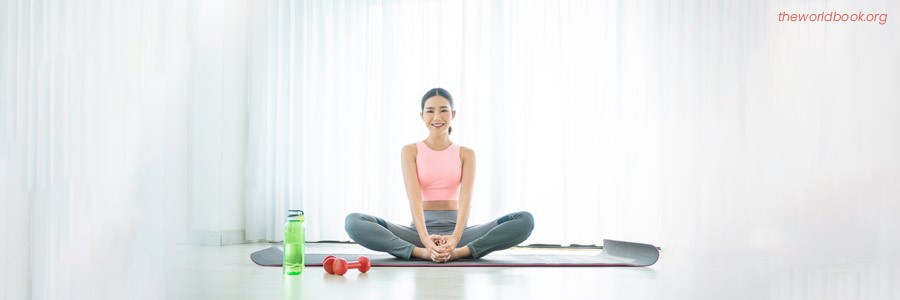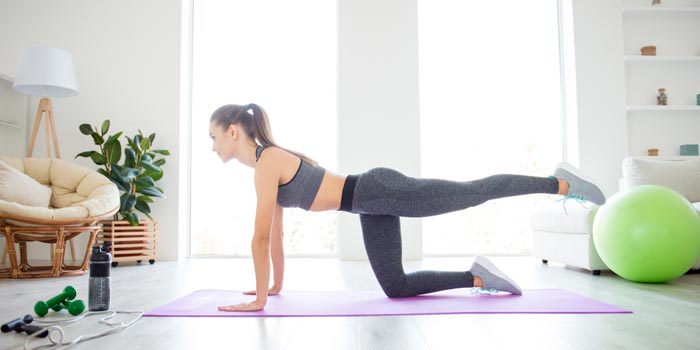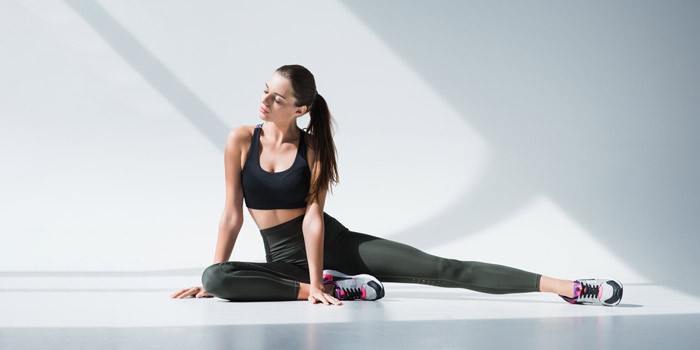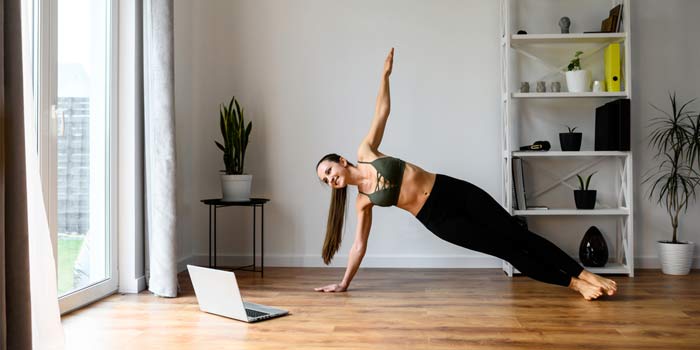Book: Health and Fitness
Author: Nayma Nishat - Researcher, Health & Fitness

Pilates exercises for beginners focus on balance, posture, strength, and flexibility. Although this method is very comprehensive for people looking to keep fit, it is also used as rehabilitation therapy.
To do Pilates exercises as beginners, you do not need great skills or be in perfect physical condition. Hence, it is a discipline suitable for people of all ages.
Plus, you can easily perform these exercises from the comfort of your home. You just have to have a disposition, concentration, and a mat.
Remember that this type of physical activity aims to relax the body and mind, so it is better to carry it out in a quiet and ventilated area.
Although the exercises are performed on devices designed for this type of physical conditioning, they can also be performed on a mat. Do you want to know more about this practice? Here I show you which Pilates exercises are best suited for beginners.
Learning Pilates is like learning to speak a new language. That of our body.
When you start practicing Pilates, you hear concepts and ideas like “activates the center “, “stabilizes the scapulae”, and “grows”. You have to maintain a fluid breath that accompanies your movements. And you discover parts of your body that you didn’t even know existed.

This path that you start now may seem overwhelming, but I assure you it will give you a great awareness of your body, how you move and your posture. What will help you improve the health of your back and prevent and improve discomfort or injury.
To achieve results it is necessary that you choose exercises that adapt to your level, to your needs. Always keeping in mind the principles on which the Pilates method is based.

One of the positive aspects of this method is that you do not need expensive materials to practice it. With a mat it is enough to start practicing Pilates. In this article I will detail everything you need to know about Pilates exercises for beginners at home.
If you want to know more about Professional Pilates Mats, click here.
In the list of Pilates exercises for Beginners, exercises will be divided into 2 parts – one is pre-pilates exercises and another is initial level exercises.
Before starting the Pilates method, it is necessary to know and practice the Principles and other pre-Pilates exercises that will provide the body with stability and awareness necessary body to perform more advanced exercises.

They are used to focus the body and mind at the beginning of a session, to refine specific aspects of an exercise emphasizing the primary biomechanical pattern, to improve the quality of movement, precision and technique, to help identify and strengthen the chain of movement and cope with personal needs.
The most suitable Pre-Pilates exercises are:
In Pilates you should practice lateral breathing. This technique allows you to hold your abs gently while keeping your upper body relaxed.
This breathing exercise is the best among pilates floor exercises for beginners.
To practice side breathing:
From lying supine with the legs bent to about 90 degrees and the feet parallel and separated to the width of the hips and the pelvis neutral. Place your hands on the iliac crests.
Perform movements of the pelvis, swinging it anteversion (cupping the lower back) and retroversion (flattening the lower part of the spine). It should be held down for 3 seconds in each position.
You can do this Pilates exercises for lower back pain.
From lying supine with the legs bent about 90 degrees and the feet parallel and hip-width apart, with the spine neutral and with the belly towards the spine.
Inhale to raise the arms towards the sky with the palms facing each other and when exhaling bring them back next to the head. Inhale and exhale do the opposite movement until you bring your arms to the ground.
Keep your arms straight throughout and your spine neutral, without dragging your ribs or pelvis. Maintain the lower back position and the Power House contraction.
From lying supine with the legs bent to about 90 degrees and the feet parallel and separated to the width of the hips and the pelvis neutral.
Inhale and exhale performing a neck flexion movement maintaining a space between the chin and the acromial space as if we were holding a tangerine.
Inhale extending your neck, gazing up at the sky. The movements should be smooth and continuous.
It begins like the previous one, exhale raising the head and continue raising the upper part of the spine, separating the shoulders from the ground. Inhale and descend slowly.
Maintain the contraction of the transverse abdominis in both movements.
Place yourself in a supine position with your legs bent at 900. Connect the transverse abdominis by bringing the lower abdomen towards the spine. Inhale to prepare and exhale by raising the leg from the hip keeping the knee flexion at 900, inhale and exhale to lower the leg until placing the foot on the ground (do not drop the leg). Repeat with the other leg.
Raise your legs to the Table Top position, first one leg and then the other.
Inhale to prepare. Exhale to extend one long leg to a 45 degree angle, while keeping the transverse abdominis activated.
Inhale to bring the leg back, then exhale and lengthen the other leg.
It is a series of exercises that start from the same position and vary depending on the difficulty. They work on central stability, the perception of neutral alignment of the spine and dissociation of the upper and lower limb.
It starts from the support on hands and knees aligned under the shoulders and hips respectively, with the pelvis and the neutral spine, with a correct alignment of the sacrum, vertebral and occipital curvatures. The balls of the feet are also in contact with the ground.
First, the shoulder girdle and head must be stabilized by bringing the scapulae in retroversion to activate the latissimus dorsi.
Dissociate upper limb: inhale to prepare and when exhale raise the arm stretched out in front, preventing the shoulder from rising. Hold position for 3 seconds. Inhale and exhale slowly descend while maintaining stability. Repeat with the other arm.
Lying on your stomach. Place your arms flexed with your palms on the floor next to your shoulders. Legs straight and feet hip-width apart.
Inhale, start by lifting the torso by lengthening the neck and continue pushing with the arms (it is not necessary to stretch the arms completely). Try not to separate the iliac crests from the ground. Keep your shoulders low, away from your ears, and pull your shoulder blades down, squeezing through the middle of your back.
Hold the stretch position for 5-10 seconds. Exhale and lower your torso gently to the ground.
Lying in the prone position (lying prone). Place the arms down at the sides of the trunk, with the palms down and the feet in Pilates position (legs in external rotation with heels together and toes apart).
Inhale, slightly lift your torso and lengthen your neck. Raise the arms in slight external rotation of the shoulders (palms face out with thumbs pointing to the sky) and pull the shoulder blades squeezing through the middle of the back.
Hold the stretch position for 10 seconds. Exhale and lower your leg gently to the ground.
Perform the exercises fluidly, moving from one exercise to another with little or no rest (one exercise flows into the next).
Perform the exercises in the most correct way possible. Each repetition must be done with good technique. Exercise should be stopped when performance is distorted.
Relax your muscles after each exercise to avoid stiffness.
Finish the routine with muscle stretching exercises: Pectoral stretch; rest position; spine stretch forward; roll down on wall and floor; cat (cat); swan neck roll; mermaid stretch.
Next, a series of simple pilates exercises for beginners will be shown for those who want to start in this discipline.

To perform them it is not necessary to have a large amount of material, in most cases, a mat pilates exercises for beginners is enough to be able to perform the exercises comfortably, and they can be easily performed from your home.
It is recommended to do it in a quiet and ventilated area (let’s not forget that it is an activity that aims to relax both body and mind).
This exercise is very simple. It is based on sitting on the mat with your legs stretched out and proceeding to try to grasp your feet with your hands, maintaining muscle tension for about fifteen seconds.
You should do multiple repetitions of this exercise.
This activity works to work your abs, shoulders, and leg muscles.
It’s one of the best mat pilates exercises for beginners. On the mat, proceed to sit hugging the legs, which will be flexed towards the thorax and resting the head on the knees.
In this position, you have to rock backward until the shoulder blades touch the ground, while inhaling, to later exhale while returning to the starting position.
Do it continuously for three minutes.
This activity is carried out from a seat and with the help of some weights or substitutes (for example two bottles of water or kettle bells).
Sitting with the feet resting on the floor at a certain distance from each other and with the back completely straight and the weights in the hands, the exercise is based on stretching the arms upwards while exhaling, and flexing them behind the neck while inhaling.
This exercise works to strengthen the triceps and helps to reduce sagging in the inner part of the arms.
It is a waist strengthening exercise. The individual sits with the legs spread and the arms and back stretched out.
Then, while inhaling, turn the trunk to the left, making an effort to grasp the left foot with the right hand.
Then perform the opposite action, turning the trunk to the right and taking the right foot with the left hand.
Repeat continuously four to five times on each side.
Another mat pilates exercise for beginners and one of the most common ways to work the upper body. Lie face down on the mat.
Then, with your knees resting on the ground and your back and head straight, do a push-up, trying to do it slowly and feeling the muscle tension.
Repeat the process at least up to ten times. If you have enough resistance, you can do it with your legs straight.
This exercise is very simple. Seat with the legs together, with the arms, stretched out. Then, while inhaling, proceed to rotate the trunk three times to one of the sides, reaching the maximum possible rotation.
Once that point is reached, return to the starting position while exhaling. Then the same procedure is repeated up to three times in the same direction, to later carry out the same three repetitions in the opposite direction.
This is one of the best pilates core exercises for beginners to work your core muscles.
On the mat, lie on as your back and your arms outstretched.
Next, the legs are raised, stretched out, up to medium height (about 45 degrees, although the inclination will depend on the capacity and resistance of each one) to proceed by also lifting the trunk and placing the arms parallel to the legs stretched.
In this way, the body forms a V, using a large number of muscles in the lumbar and abdominal area, in addition to the muscles of the legs and arms.
This exercise is performed while standing, with the arms stretched upwards. Proceed as in the case of the initial stretch to lower the arms until reaching the ground.
Then you proceed to walk with your hands forward, being able to rest your knees on the ground. Then proceed to do a series of three push-ups (resting the knees on the ground).
Finally, one proceeds to return to the starting position, chaining the steps followed so far in reverse. You can do several repetitions.
The present activity is carried out as follows: first, while lying on your back on the mat, you begin by stretching both legs and placing them at a ninety degree angle to the body.
Once this is done, we proceed to hug one of the stretched legs while the other recovers the original position, resting on the floor fully stretched out.
After between one and two seconds of maintaining this position, go up and hug the other leg and lower the one that was previously, alternating in several repetitions (at least two sets of ten).
This exercise can be used to practice elasticity of the muscles, and it also strengthens the thighs.
This activity, while simple, may require some effort.
On this occasion the individual has to lie face up on the mat. Next, with the arms outstretched serving as support, proceed by raising the legs at a right angle.
After a few seconds (we recommend ten), and with your legs straight, continue the movement until your feet are in front of your head, touching the ground.
After several seconds in this position, the legs are returned to 90 degrees with respect to the body, that is, in their previous position. Finally the legs are lowered until they are fully stretched.
It is recommended to perform several repetitions, depending on the resistance of each one.
As we mentioned, Pilates is one of the best disciplines if you want to work both physically and mentally. However, as in all exercise routines, there are some recommendations that should be taken into account before starting, such as the following:
Listen To Your Body: whether you decide to do it alone or with the support of a coach, it is important that you become fully aware of the movements to understand what alignment problems your body has. This will help you work your postures better to relieve and avoid muscle aches.
Inhale And Exhale Deeply: breathing properly will not only help you go further and further in the exercise, but also to relax your body and avoid unnecessary stress.
Know How Far To Go: remember that all bodies are different. Therefore, avoid comparing yourself with others and do not demand more of yourself.
When you’ve done with these exercises, move to the Advanced Pilates Reformer Exercises.
Now you know the basic Pilates exercises for beginners to get started in this discipline, do not hesitate to get your mat and see its benefits for yourself.
Pilates method is often used as rehabilitation in cases of back pain or posture problems, in addition to promoting a healthy weight and a slim figure. If you want to start training with this discipline now, take note of the three exercises you should start with.
Keep in mind the tips in the list above and don’t forget to work on the postures to avoid further injury.
© 2025 The World Book. All Rights reserved.
Founder: Nayma Nishat